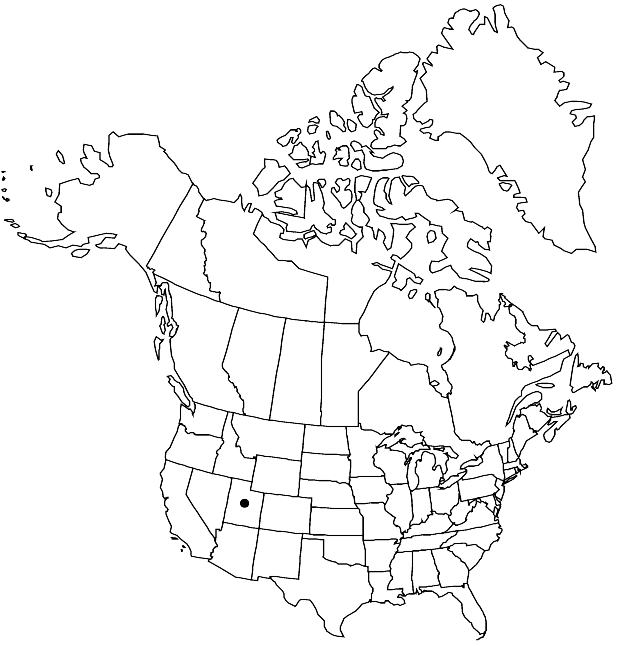Difference between revisions of "Physaria lepidota"
Brittonia 33: 335, figs. 1, 2. 1981.
FNA>Volume Importer |
RevisionBot (talk | contribs) m (Bot: Adding category Revised Since Print) |
||
| (7 intermediate revisions by 3 users not shown) | |||
| Line 8: | Line 8: | ||
}} | }} | ||
|common_names=Kane County twinpod | |common_names=Kane County twinpod | ||
| + | |special_status={{Treatment/ID/Special_status | ||
| + | |code=E | ||
| + | |label=Endemic | ||
| + | }} | ||
|basionyms= | |basionyms= | ||
|synonyms= | |synonyms= | ||
| Line 20: | Line 24: | ||
-->{{Treatment/Body | -->{{Treatment/Body | ||
| − | |distribution= | + | |distribution=Utah |
|discussion=<p>Subspecies 2 (2 in the flora).</p> | |discussion=<p>Subspecies 2 (2 in the flora).</p> | ||
|tables= | |tables= | ||
| Line 44: | Line 48: | ||
-->{{#Taxon: | -->{{#Taxon: | ||
name=Physaria lepidota | name=Physaria lepidota | ||
| − | |||
|authority=Rollins | |authority=Rollins | ||
|rank=species | |rank=species | ||
| Line 51: | Line 54: | ||
|basionyms= | |basionyms= | ||
|family=Brassicaceae | |family=Brassicaceae | ||
| − | |distribution= | + | |distribution=Utah |
|reference=None | |reference=None | ||
|publication title=Brittonia | |publication title=Brittonia | ||
|publication year=1981 | |publication year=1981 | ||
| − | |special status= | + | |special status=Endemic |
| − | |source xml=https:// | + | |source xml=https://bitbucket.org/aafc-mbb/fna-data-curation/src/2e0870ddd59836b60bcf96646a41e87ea5a5943a/coarse_grained_fna_xml/V7/V7_1087.xml |
|tribe=Brassicaceae tribe Physarieae | |tribe=Brassicaceae tribe Physarieae | ||
|genus=Physaria | |genus=Physaria | ||
| Line 62: | Line 65: | ||
}}<!-- | }}<!-- | ||
| − | -->[[Category:Treatment]][[Category:Physaria]] | + | --> |
| + | |||
| + | [[Category:Treatment]] | ||
| + | [[Category:Physaria]] | ||
| + | [[Category:Revised Since Print]] | ||
Latest revision as of 17:14, 6 November 2020
Perennials; caudex simple, (with deep roots, thickened); densely (silvery) pubescent throughout (densely covering leaves with several appressed layers), less dense on stems, trichomes (stellate-scalelike), rays fused (webbed) in proximal 1/2 or to tips, (umbonate, nearly smooth to moderately tuberculate). Stems simple from base, erect or outer ones slightly decumbent toward base, (from below or in basal leaves, unbranched), (0.5–)0.8–1.6(–2) dm. Basal leaves (erect, petiole long, slender); blade spatulate to broadly oblanceolate, (3–)5–7(–12) cm, (base gradually tapering to petiole), margins entire, (apex rounded or obtuse). Cauline leaves: blade oblanceolate, similar to basal, (base cuneate), margins entire. Racemes dense. Fruiting pedicels (divaricate-ascending, straight or slightly curved), 10–15 mm. Flowers: sepals (erect), linear to linear-oblong, somewhat boat-shaped, 7–10 mm; petals (erect at anthesis), lingulate, 11–15 mm, (claw undifferentiated from blade). Fruits (purplish in age), strongly didymous, semiorbicular, highly inflated, 10–18 × 14–19 mm, (papery), basal sinus usually shallow, rarely absent, apical sinus deep, narrowly V-shaped; valves retaining seeds after dehiscence, sides flat, back rounded, margins keeled, base and apex obtuse; replum narrowly oblong to linear, as wide as or wider than fruit, base slightly narrowed, apex obtusely rounded; ovules 4 per ovary; style 3–5 mm, (slender). Seeds slightly flattened.
Discussion
Subspecies 2 (2 in the flora).
Selected References
None.
Key
| 1 | Trichomes: rays fused nearly to tips; fruits with deep sinuses, or shallow basally, deep apically. | Physaria lepidota subsp. lepidota |
| 1 | Trichomes: rays fused in proximal 1/2; fruits with sinuses absent or shallow basally, deep apically. | Physaria lepidota subsp. membranacea |
